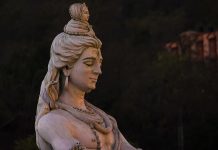The human eye carries a strong symbolism in different cultures around the world, and until the present day, it is possible to find it in different representations, from myths, legends, and superstitions. We are going to deal here with six examples that demonstrate how humanity is fascinated by the eyes. follow up.
Greek eye

One of the objects most used by people who wish to ward off evil forces, the Greek eye (known in some places as the Turkish eye), an image of a cobalt blue eye, is found in many regions. This amulet is meant to ward off a curse passed through a malicious look, provoked by envy.
Its origin is believed to be from ancient Greece or Rome, but the concept of the evil eye finds repercussions in other parts of the world, such as the “fat eye” in Brazil and the “mal de Ojo” in Mexico. The most common representation of him has already entered popular culture, even reaching the catwalks of major brands in the fashion world.
Eye of Horus

The Eye of Horus is an original symbol from ancient Egypt, which would have been created to reproduce the look of Horus, one of the main Egyptian gods. It is made up of parts of an eye, such as the eyelids, iris, and eyebrow, but features tears as an additional element.
The symbol represents strength, power, courage, protection, and health, while the tears would refer to the pain in the battle in which the Egyptian god lost his eye. Present in different cultures around the world, it is considered an amulet of luck and protection.
Daruma

Very popular in Japan, Darumas are amulets whose large eyes jump out at anyone who sees them. In local culture, it is seen as a good luck charm and a reminder of goals you may have in life.
He would represent Bodhidharma, an Indian monk who founded Zen Buddhism, and during his Buddhist enlightenment process would have plucked his eyelids so he wouldn’t sleep while meditating.
In Japan, the doll is offered as a gift, but without painting the eyes, which is the responsibility of whoever wins the Daruma, who must make a wish while painting.
Eye of Shiva

For Hinduism, Shiva is one of the main gods, considered the creator of yoga. Represented by a male figure, who appears seated in the lotus position, he has four arms and, on his forehead, a third eye called the Eye of Shiva. This eye would symbolize intelligence and the destructive fire of renewal.
In Indian culture, women wear an ornament called a bindi in the center of the forehead, representing the third eye. It is believed that they are more sensitive, having an easier time opening the third eye. In Western culture, it would be the equivalent of female intuition. Men do tilak in the same place, only for specific ceremonies.
Eye of Providence

Also called “the all-seeing eye, the Eye of Providence is a symbol with different interpretations but many conspiracy theories. Of Christian origin, it was found in many Renaissance paintings, in the 16th century, as a way to represent God.
Some define him as the personification of divine benevolence, which would confirm that his invention was to show how God keeps watching over humanity. It is not known who invented it, but the inspiration would come from the Eye of Horus, one of the first symbols to use an isolated eye.
Santa Luzia’s eyes

Saint protector of the eyes, Luzia is famous for her representation with a plate containing a pair of eyes.
Historians claim that this would refer to the loss of eyes during life, but some argue that the origin of the Eyes of Santa Luzia would be in the fact that she would have plucked them, to reduce the yearnings of a suitor who claimed that they were beautiful.


























































